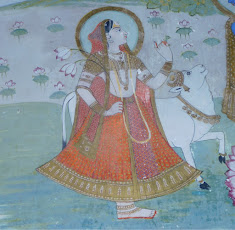CONNECTING THE DOTS: A CASE OF BANDHANI
CONNECTING
THE DOTS: A CASE OF BANDHANI
Name
of the article - Connecting the Dots: A case of Bandhani
Name of Place - Jaisalmer Fort,
Jaisalmer, and Mehrangarh Fort, Jodhpur
Article written by - Ms. Radhika Malhotra
Edited by - Mrs. Srishti Safaya
The
walls of various forts, havelis, and
other buildings across Rajasthan are ornamented with paintings based on a
myriad of themes which range from religious portraits to everyday life scenes
to extravagant lives of royalties and the portraits of British officials.
In
few of the paintings found on the walls of Jaisalmer Fort, it can be noticed
that the portraits of Goddess Radha,
Goddess Parvati and of a lady painted
on the walls of the Mehrangarh Fort, Jodhpur, are bound by a common factor
which are the clothes of the subjects embellished with the tie-dye technique
called bandhani.
Bandhani
is a type of patterned fabric that is crafted with expertise steeped in age-old
traditions and knowledge system that has passed down from one generation to the
other. This art of tying and dyeing has been in existence in the said region for
centuries and its appearance on the wall paintings at Jaisalmer and Jodhpur
only cements the continuation of this tradition.
With
major centers of production situated at Jaipur, Bikaner, Ajmer, and Jodhpur,
the dotted pattern adorns fabrics like cotton, georgette, and chiffon to
produce odhanis (veil), pag (turban) and ghaghras (full-gathered skirts) often influenced and demarcated by
social hierarchy and regional variations.
The
intricate process includes preparing, printing, or tracing the design on the
chosen cloth either through wooden blocks or tracing them using a stencil. The
areas which are to resist dye are pinched, knotted, and secured by a thread
which is generally done by women. The cloth is then immersed in the dye, washed,
and left in the sun. After having dried, the cloth is untied revealing a dotted
pattern created by the tied areas. The process is repeated for each color
incorporated in the design starting from a lighter to a darker shade. The
intricacy, uniformity, and symmetry observed on the textile and the color palette
employed completely relies on the skill of the artisan.
The
patterns that have been popular in Jaisalmer, Jodhpur, and the surrounding
areas include simplistic, concentric circles or squares assembled in a repetitive
pattern called dabbi which were generally
used on cotton, and muslin fabrics. The complicated versions of the same
pattern adorned chiffon and georgette materials which were often meant for the
royalty.
The
same can be observed in the wall paintings that have been executed in the ala-gila technique which requires the
artist to paint on fresh lime plaster with pigments mixed with binding agents.


(Left) Fig. a)- Painting of Goddess Radha clad in bandhani attire. (Right) Fig. b) A close up image of Fig. a) (Location-Jaisalmer Fort)
In
Fig.(a), Goddess Radha is shown wearing a ghaghra embellished with light-coloured
dots against a bright orange background while a georgette/ chiffon odhani falls gracefully over her shoulders,
patterned with an intricate and complex bandhani
design. Similarly, in Fig.(c), the
lady is decked in a dark blue attire speckled with bright yellow coloured dots
and a translucent odhani decorated
with the same pattern covering her head and her torso.
The dabbi pattern is also observed on the ghaghra and odhani sported by Goddess Parvati in Fig.(e) and Goddess Radha in Fig.(g) respectively in a color palette that suits and contrasts the terrain of the region in context.


(Left) Fig. g)- Painting of Lord Krishna trying to persuade an exasperated Goddess Radha by combing her hair. (Right) Fig. h)- A close up image of Fig. g) (Location-Jaisalmer Fort)
The
bandhani textile and its patterns
were diversified for the consumption of various communities with the colour,
design, and fabric acting as a source of identification of the social position,
communities, and marital status of the person. Its popularity has only led to
the mass production and consumption of the coveted textile so much so, that the
industrious and traditional process has been compromised to produce the same.
Now, factory-made and printed versions have flooded the market mainly due to
the time-consuming process and the specialised skills that are required to commission
the original versions.
However,
several artisans continue to practice the traditional process that has been
transferred intergenerationally, safeguarding their legacy and are a flickering
ray of hope who would ensure the continuity of this centuries-old craft.
The
wall paintings depicted here also stands a testimony to the culture and
tradition that was and subtly highlights the need for preservation of the
traditional craft of bandhani.
- Chattopadhyaya,
K. (1980) India’s Craft Tradition. Internet Archive.
Available at:
https://archive.org/details/indiascrafttradi00chat/page/n8/mode/1up(Accessed: 21
November 2022).
- Map
Academy. (no date) Bandhani.
Available at:
https://mapacademy.io/article/bandhani/ (Accessed: 22 November2022).
- Rajasthan Textiles. (no date) Dyed
Textile- Social Significance in Culture of Rajasthan.
Available at:
http://www.rajasthantextiles.com/bandhani-change.htm (Accessed: 18 November
2022).







Comments
Post a Comment